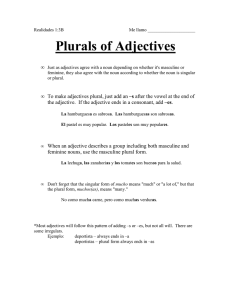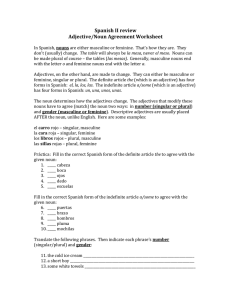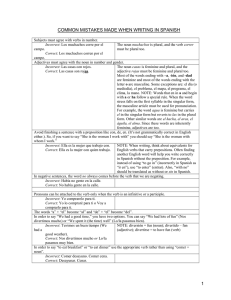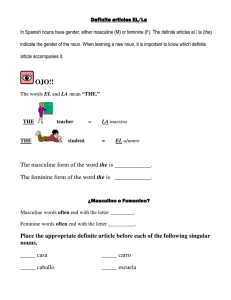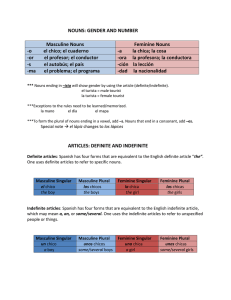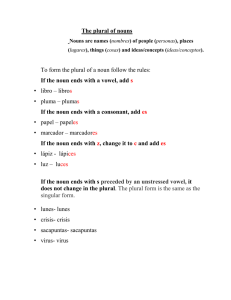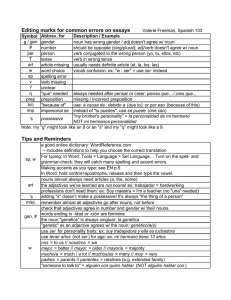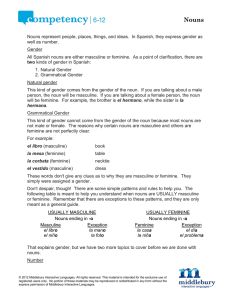Dictionary skills
Anuncio
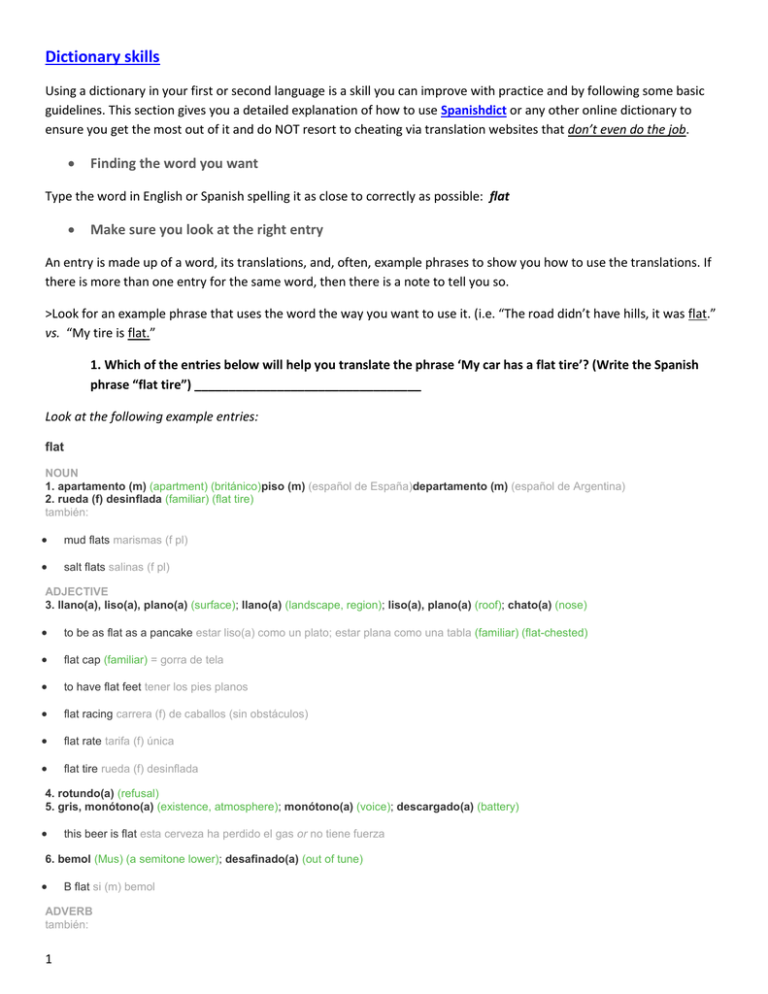
Dictionary skills Using a dictionary in your first or second language is a skill you can improve with practice and by following some basic guidelines. This section gives you a detailed explanation of how to use Spanishdict or any other online dictionary to ensure you get the most out of it and do NOT resort to cheating via translation websites that don’t even do the job. Finding the word you want Type the word in English or Spanish spelling it as close to correctly as possible: flat Make sure you look at the right entry An entry is made up of a word, its translations, and, often, example phrases to show you how to use the translations. If there is more than one entry for the same word, then there is a note to tell you so. >Look for an example phrase that uses the word the way you want to use it. (i.e. “The road didn’t have hills, it was flat.” vs. “My tire is flat.” 1. Which of the entries below will help you translate the phrase ‘My car has a flat tire’? (Write the Spanish phrase “flat tire”) _________________________________ Look at the following example entries: flat NOUN 1. apartamento (m) (apartment) (británico)piso (m) (español de España)departamento (m) (español de Argentina) 2. rueda (f) desinflada (familiar) (flat tire) también: mud flats marismas (f pl) salt flats salinas (f pl) ADJECTIVE 3. llano(a), liso(a), plano(a) (surface); llano(a) (landscape, region); liso(a), plano(a) (roof); chato(a) (nose) to be as flat as a pancake estar liso(a) como un plato; estar plana como una tabla (familiar) (flat-chested) flat cap (familiar) = gorra de tela to have flat feet tener los pies planos flat racing carrera (f) de caballos (sin obstáculos) flat rate tarifa (f) única flat tire rueda (f) desinflada 4. rotundo(a) (refusal) 5. gris, monótono(a) (existence, atmosphere); monótono(a) (voice); descargado(a) (battery) this beer is flat esta cerveza ha perdido el gas or no tiene fuerza 6. bemol (Mus) (a semitone lower); desafinado(a) (out of tune) B flat si (m) bemol ADVERB también: 1 he lay flat on the floor estaba tumbado en el suelo to fall flat on one's face caer de bruces the joke fell flat (sentido figurado Never take the first translation you see without looking at the others. Always look to see if there is more than one translation underlined. Words often have more than one meaning and more than one translation. For example, a pool can be a puddle, a pond or a swimming pool; pool can also be a game. When you are translating from English into Spanish, be careful to choose the Spanish word that has the particular meaning you want. The dictionary offers you a lot of help with this. Look at the following entry: pool NOUN 1. (place to swim) a. la piscina (f) We swim at the pool every Saturday.Nadamos en la piscina todos los sábados. b. la alberca (f) (Mexico) The new pool can be used at night.La alberca nueva se puede utilizar por las noches. c. la pileta (f) (Argentina) The kids had a great time at the pool.Los niños se lo pasaron chévere en la pileta. 2. (puddle) a. el charco (m) (of any liquid) The dishwasher is leaking and now there's a pool of water on the kitchen floor.El lavaplatos está chorreando y ahora hay un charco de agua en el piso de la cocina. b. la charca (f) (of water) We loved swimming in the forest pool as kids.De niños nos encantaba nadar en la charca del bosque. 3. (billiards) a. el billar americano (m) He is very good at playing pool.Es muy bueno jugando al billar americano. 4. (gambling) a. el bote (m) Who won this year's March Madness office pool?¿Quién ganó el bote de March Madness de la empresa este año? The numbers tell you that there is more than one possible translation and the words in brackets in italics after the translations help you choose the translation you want. 2. How would you translate ‘I like playing pool’? Me gusta jugar ___________________________ 2 Also, you must understand what part of speech* you are using. >When looking up “flat,” it helps you choose the best entry faster if you know you’re looking for an adjective. Are you using the word as a noun(person, place, thing, or idea), verb(action or state of being), adjective(describes a noun), an adverb(describes a verb, adjective, or adverb), a preposition(links a noun to another word), a pronoun (replaces a noun), a conjunction (joins words, clauses, or senteneces), or an interjection (short exclamation)? 3. Give two examples from the chart using the link with the asterisk* for each part of speech: Noun_______________________ Verb____________________________ Adjective____________________________ Preposition____________________________________ Pronoun_____________________________ Conjunction___________________________________ Parts of speech If you look up the word flat, you will see that there are two entries for this word as it can be a noun or an adjective. It helps to choose correctly between entries if you know how to recognize these different types of words. Nouns and pronouns Nouns often appear with words like a, the, this, that, my, your and his. They can be singular (abbreviated to sing in the dictionary): his dog her cat a street or plural (abbreviated to pl in the dictionary): the facts those people his shoes our holidays They can be the subject of a verb: Vegetables are good for you or the object of a verb: I play tennis Words like I, me, you, he, she, him, her and they are pronouns. They can be used instead of nouns. You can refer to a person as he or she or to a thing as it. I bought my mother a box of chocolates. 4. Which three words in this sentence are nouns? _____________________________________ 5. Which of the nouns is plural? _______________________________________ 6. Which word is a pronoun? __________________________________ Spanish nouns are either masculine or feminine (abbreviated to masc and fem). Masculine nouns are shown by el: el hombre el gato Feminine nouns are shown by la: 3 el fútbol la mujer la economía la fábrica The plural forms of el and la are los and las. The plural of most Spanish nouns is made by adding s if the word ends in a vowel, or es if it ends in a consonant: los gatos las mujeres 7. zapato – How do you write “three shoes”? tres __________ 8. rosal- How do you write “five rose bushes”? cinco ____________________ Adjectives Flat can be an adjective as well as a noun. Adjectives describe nouns: your tire can be flat, you can have a pair of flat shoes. 9. In which sentence is ‘dark’ an adjective? ______________________________________________ I’m afraid of the dark. The girl has dark hair. Spanish adjectives can be masculine or feminine, singular or plural, depending on the noun they describe: un chico guapo (masc sing) una chica guapa (fem sing: replace -o of masculine with -a) unos chicos guapos (masc pl = masculine singular + s) unas chicas guapas (fem pl = feminine singular + s) Regular adjectives are listed in the singular form in the dictionary. So if you want to find out what kind of houses unas casas viejas are, look under viejo. 10. What word should you look up in Spanish if you want to know what casas doradas are? _____________ There are separate masculine and feminine, singular and plural forms for irregular adjectives of nationality, and those ending in -án, -ín, -ón, eg español masculine singular, española, feminine singular, españoles masculine plural, españolas feminine plural. Adjectives ending in -or also follow the above pattern unless they are comparatives. The feminine is shown in the dictionary for adjectives of this type. hablador, -ora ADJECTIVE 1. talkative 4 MASCULINE OR FEMININE NOUN 2. chatterbox Other adjectives ending in a consonant do not have a separate feminine form, but do change in the plural, eg azul masculine and feminine singular, azules masculine and feminine plural. If the masculine form of an adjective ends in -e or -a, the feminine form is the same, and both the masculine and feminine plurals are formed by adding -s to the masculine, eg verde masculine and feminine singular, verdes masculine and feminine plural. Some adjectives remain the same whether they’re masculine, feminine or plural. This is also shown in the dictionary: 11. formal- How do you write “two formal dances”? Dos bailes _________________ Verbs She’s going to record the program for me. His time in the race was a new world record. Record is a verb in the first sentence. In the second, it is a noun. One way to recognize a verb is that it frequently comes with a pronoun such as I, you or she, or with somebody’s name. Verbs can relate to the present, the past or the future. They have a number of different forms to show this: I’m going (present), he will go (future), and Nicola went by herself (past). Often verbs appear with to: they promised to go. This basic form of the verb is called the infinitive. (In Spanish and infinitive consists of only ONE word that ends in –ar, -er, -ir.) **Generally in dictionaries verbs are preceded by ‘to’, so you can identify them at a glance. No matter which of the four previous examples you want to translate, you should look up ‘to go’, not ‘going’ or ‘went’. If you want to translate ‘I thought’, look up ‘to think’. 12. What would you look up to translate the verbs in these phrases? I came _______ she’s crying _________ they’ve done it ______ he’s out _______ Verbs have different endings in Spanish, depending on whether you are talking about yo, tú, nosotros etc: yo hablo, tú hablas, nosotros hablamos etc. They also have different forms for the present, future, past etc. Hablamos (we speak = present), hemos hablado (we spoke = past), hablaremos (we will speak = future). Hablar is the infinitive and is the form that appears in the dictionary. Sometimes the verb changes completely between the infinitive form and the yo, tú, él etc form. For example, to give is dar, but I give is doy, and digo comes from decir (to say). 5 When you look up a verb on Spanishdict above the word you will see the options “dictionary” or “conjugation”. Once you’ve read the definition options and are sure it’s the right word, CLICK ON CONJUGATION! There you will see all the choices that will help you say what you mean. If a verb has irregular forms it will show them in red to help you pay attention to the difference from the regular –ar, -er, -ir patterns. –morir= to die. If you’re looking up a word during lectura libre and you’re not sure if it’s a regular verb, or if you have no idea what the infinitive is, you can type in the like “puedo”(from poder= to be able to) and it will show you the infinitive and the conjugation. That’s the difference between a paper vs. online dictionary. It’s a good idea to get into the practice of making educated guesses about a verb’s infinitive like, plactican is probably an –ar verb because it ends in “an”. That doesn’t always work, but you can check your guess using Spanishdict. The other resource you have is your VERB CHEAT SHEET that shows you the regular forms for –ar, -er, -ir in the present and past tenses as well as the most common irregular and stem changing verbs. *When dealing with verbs a dictionary is USELESS unless you use the conjugation option or your verb cheat sheet. Otherwise you will sound like a caveman or Cookie Monster forever: “I eat hamburger yesterday.” 13. What is the infinitive of the verb “vuelves”? _______________________________ 14. Does it have any irregular forms in the present? ________ If so, give an example: _________________ Adverbs An adverb is a word that describes a verb or an adjective: Write soon. Check your work carefully. The film was very good. In the sentence ‘The swimming pool is open daily’, daily is an adverb describing the adjective open. In the phrase ‘my daily routine’, daily is an adjective describing the noun routine. We use the same word in English for both adjective and adverb forms, but to get the right Spanish translation, it is important to know if it’s being used as an adjective or an adverb. When you look up daily you find: daily NOUN 1. diario (m) periódico (m) (newspaper) ADJECTIVE 2. diario(a) on a daily basis a diario our daily bread el pan nuestro de cada día the daily grind (familiar) la rutina diaria 6 daily paper diario (m) , periódico (m) ADVERB 3. diariamente twice daily dos veces al día The examples show you daily being used as an adjective and as an adverb and will help you choose the right Spanish translation. Take the sentence ‘The menu changes daily’. 15. Is ‘daily’ an adverb or an adjective here? ________________________ Prepositions Prepositions are words like for, with and across, which are followed by nouns or pronouns: I’ve got a present for David. Come with me. He ran across the road. The party’s over. The shop’s just over the road. 16. Which sentence shows a preposition followed by a noun? __________________________ Making use of the phrases in the dictionary Sometimes when you look up a word you will find not only the word, but the exact phrase you want. For example, you might want to say ‘What’s the date today?’. Look up date and you will find that exact phrase and its translation. Sometimes you have to adapt what you find in the dictionary. If you want to say ‘I ate a sandwich’ and look up eat you will find: eat TRANSITIVE VERB 1. (to consume) a. comer I haven't eaten anything since this morning.No he comido nada desde esta mañana. Remember that you will either need to use your VERB CHEAT SHEET to look at an example for an –er verb in the past(you wanted to say “I ate a sandwich”), or click on the “conjugation” option. There you will see that the “yo” form for comer in the past is “comí.” 7 You have to substitute comí for the infinitive form comer. You will often have to adapt the infinitive in this way, adding the correct ending and choosing the present, future or past form. 17. How would you say ‘I don’t eat meat’?(carne=meat) ___________________________________ Phrases containing nouns and adjectives also need to be adapted. You may need to make the noun plural, or the adjective feminine or plural. Remember that some Spanish nouns and adjectives change their spelling in the feminine or plural and that this is shown in the entry. 18. How would you say ‘The boys are Spanish’? Los chicos son ________________________ Don’t overuse the dictionary It takes time to look up words so try to avoid using the dictionary unnecessarily, especially in exams. Think carefully about what you want to say and see if you can put it another way, using words you already know. To rephrase things you can: > Use a word with a similar meaning. This is particularly easy with adjectives, as there are a lot of words which mean good, bad, big etc and you’re sure to know at least one. > Use negatives: if the cake you made was a total disaster, you could just say it wasn’t very good. > Use particular examples instead of general terms. If you are asked to describe the sports facilities in your area, and time is short, you could say something like ‘In our town there is a swimming pool and a football field.’ 19. How could you say ‘Argentina is huge’ without looking up the word ‘huge’ ? Argentina es ______________. You can also often guess the meaning of a Spanish word by using others to give you a clue. If you see the sentence ‘María lee un buen libro’, you may not know the meaning of the word lee, but you know it’s a verb because it’s preceded by María. Therefore it must be something you can do to a book: read. So the translation is: María is reading a good book. 20. Try NOT to use your dictionary to work out the meaning of the sentence: ‘La chica le escribe una carta a su amiga en español’. _________________________________________ 8 ANSWERS 1. rueda desinflada 5. chocolates 9. The girl has dark hair. 2. al billar (Americano) 6. I 10. dorado 3. (see table) 7. zapatos 11. formales 4. mother, box , chocolates 8. Rosales 12. Come, cry, do, is 13. volver 17. No como carne. 14. yes, vuelvo, vuelve, vuelven 18. españoles 15. adverb 19. grande, muy grande 16. over the road 20. The girl writes a letter to her friend in Spanish. 9
